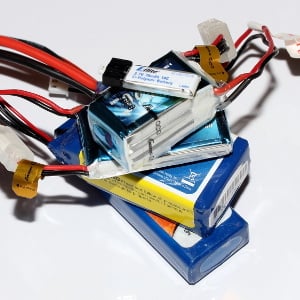LiPo Battery "Care and Feeding"

Learn proper care and safety for your R/C batteries.
New Radio control vehicles rely on LiPo battery technology due to their lightweight nature and high power output for their size. However, without alarming anyone, these batteries need to be cared for and treated with respect. Improper use can cause irreparable damage to the battery, which is disappointing to the customer, or in extreme cases can cause burns or fires. We have learned many of these characteristics through the school of hard knocks and wish to pass them on so others do not have to go through the same pain. With proper care these batteries should last a very long time and be very reliable. I have some that are more than 4 years old and still working fine.
| First let’s examine how LiPo batteries are connected to a charger. It will vary some with the number of cells the battery has. LiPo batteries are built by combining several layers of cells to reach a desired voltage level. For example, the output of a single LiPo battery is rated at 3.7V. From there you multiply the number of cells by 3.7, so a 2 cell is 7.4 V, a 3 cell is 11.1V etc. It is important to know the number of cells in your battery to match your charger’s settings to the right voltage level of the battery you are charging. |
|
Next is the connection of the battery to the charger. For a single cell battery, there is normally only one connector. The main power connection also works as the charge port. From there, most LiPo batteries will have two connectors coming from the body. One is for the power input/output, and the second is to balance the charge rate between cells as the battery charges. Both connections must be in place to charge a LiPo battery. That is why it is important to make sure you use a charger designed to work with LiPo batteries. There are some basic chargers (usually included in ready to run vehicles) that only use the balance board connection to the charger. This is OK; it just means the charge cycle takes longer because less current will be going to the battery. NEVER use a charger that is designed only for Ni-Cads or NIMH batteries. If hooked to a LiPo battery it will damage it and could cause a fire. Only uses the main power connection to connect to the battery. Normally for the LiPo you will plug in the main power connector to the main charge port and the charger will have a smaller board that allows the attachment of the balance connector.
Recently, several LiPo manufacturers are starting to combine the balance feature into the construction of the battery pack. These have been called “smart charge systems” and there is only one connector from the main battery pack. There is no visible balance connector. These battery packs must be used with their proprietary chargers to work properly. Examples of these charge systems include Traxxas and Spektrum. Also be aware that these charge systems are not compatible with batteries designed to use a separate balance connection.
1. Handling- LiPo batteries should be carried and stored in a fireproof container. A basic LiPo bag can be purchased for around $10 and looks like a miniature pizza bag used to keep delivery pizzas warm. Also old METAL military ammo boxes work well. We use these in case there is an emergency with the battery, the enclosure will contain it and prevent further cascading events.
2. Hobby LiPos can become damaged once their individual cell voltage dips below 3.5 V and they can become unstable below 3V. A good storage voltage is 3.7 volts if the battery will not be used for a period of several days or weeks.
3. A fully charged voltage per cell should not exceed 4.2V.
4. Let your LiPo cool before charging it. It will normally be warm when removed from the vehicle.
5. Unplug LiPos when not in use. This means between EVERY flight or run. Do NOT leave them on the charger unattended, either. Switches and electronics can fail or may be draining small voltages that go unnoticed until the battery is damaged.
6. It is our experience that LiPos do not like the cold, and storage below 30 degrees F seems to cause long term damage to the battery chemistry. Most often this occurs when we forget to bring them in from the car during the winter time. This shows up as the battery seeming to take a charge from the charger but the output is greatly reduced from original performance levels.
7. If a LiPo fails it is likely in one of these ways:
a. Battery has become discharged below 3.5V per cell. If done over a long time (leaving it plugged in for a few hours for example) the normal problem is it will not take a new charge and is no longer usable.
b. Battery is discharged below 3.5V at a high rate. For example flying a plane, quad, boat, or running a car for too long and draining the battery down below minimum voltage level. Also using a high performance motor and speed control that may drain the battery at a higher rate than it is designed for. This will most often result in what we call a "puff" where the battery will swell up to several times its size while its’ packaging attempts to contain the chemical reaction in the battery. It gets VERY hot so beware of getting burned. If the battery swells and you can still handle it, put the battery immediately into the carrying box or LiPo bag until cools. DO NOT attempt to reuse or
charge a puffed LiPo. The chemistry is altered and the battery is no longer stable.
c. Damage due to crash. If the battery packaging is damaged or punctured in a crash it is best to dispose of it. If the package is compromised it will no longer contain a swell and can cause fire if discharged or charged. A puff can also occur due to a crash, with the same results listed in the previous section. Minor wrinkles and banged corners are normally OK. Just keep a close eye on a suspect battery when charging and if possible monitor the cell individually during the charge process.
d. Fast charging a battery too many times without doing a balance charge. This shows up for more advanced LiPo users, but the individual cells can achieve various voltages during a fast charge. If done enough times it can damage the battery to where it can no longer be balanced and therefore will not take a fresh charge. Using a balance charge or 1C charge rate usually prevents this issue (but is also slower!)
If a battery is damaged it is best to take it to a professional disposal area. Most Home Depot, Batteries Plus, and Lowe's Stores have bins for LiPo disposal now.
At Hobbyland we hope you enjoy your new R/C vehicle. There could be entire books written on the subject of LiPo batteries, but we hope these guidelines will enable you to have a safe and enjoyable time with your hobby. Please feel free to ask about batteries and chargers that are appropriate to your branch of the hobby so we can match up the best combo for your needs.


Comments
Be the first to comment...